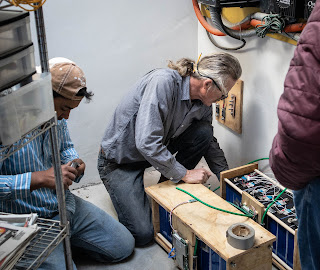Taking the Lithium Ferro Phosphate Cure
After a little over 12 years of service, a few weeks ago we replaced the two monster lead acid battery packs of our solar electric system with a deceivingly petite set of lithium ferro phosphate (LFP) batteries. The change felt somewhat comparable to trading in a lumbering, gas-guzzling—but familiar—2009 Crown Victoria for a snazzier set of wheels, far nimbler and more efficient, but whose mechanical innards you don't quite understand yet.
 |
| Good bye old friends |
The two original quarter-inch thick metal battery cases, each holding six lead-acid batteries, weighed about 900-pounds each and are often used in forklifts, as both a power source and counterweight.
Our batteries resided just outside the garage in a dedicated mechanical closet by now badly stained with battery acid. To take apart the two packs, and remove the individual batteries inside, required a radial saw, crowbars and some spirited banging with a metal mallet.
The reason for their retirement was declining performance of their storage capacity, which required us to use a generator if there was more than one day of cloudiness. If we accidentally turned on more than one heavy user of electricity, say, the dishwasher and microwave, or any other such combination, the system could crash.
Whither the old batteries, I'm not sure. But I suspect that a Mexican junk yard will resell the metal enclosures, perhaps give the 16 old battery units a second life, or even cannibalize the contents down to the lead and battery acid.
I wish I could describe our experience with solar electricity as a smooth, virtuous arc, but instead at times it was more like the jagged line of a seismograph, particularly during the first couple of years.
I blame most of the startup problems on the incompetence of our first installer—an American retiree who after a successful stint as a Midas muffler franchisee decided to launch a new career here in the solar energy business—rather than on the equipment itself or the technology.
Even with an energy conservation lifestyle befitting a Trappist monastery, we experienced recurring blackouts blamed by the installer on ever more inventive causes. My favorite was a mysterious "energy drop" somewhere that made our new house almost sound haunted. The particularly dark and rainy 2009-10 winter didn't help.
With the help of another American installer who actually knew what he was doing, we gradually corrected the problems, redid the improper wiring of the solar panels, inverter and controllers, and added eight more solar panels for a total array of 20.
Lessons learned? Obviously, find yourself an experienced person to design and build your solar system. At least in our neck of the Mexican woods, solar installers seem to be proliferating, and many of them are charlatans or fly-by-nighters.
Second, a failsafe option is to oversize the system rather than playing on the edge. Even in seemingly eternally sunny locations like central Mexico there will be days and even weeks of intermittent clouds and rain, and modern "essentials" like dishwashers, jumbo TVs, microwave ovens, meat locker-size refrigerators, and large clothes washers and driers consume a lot of juice, particularly if they decide to come out and play simultaneously.
Our new LFP array at first seemed suspiciously small, almost toy-like, compared to our old batteries. I can't begin to explain the different chemical reactions and electric storage characteristics of each system because, frankly, I don't understand them, despite my above-average performance in high school science class.
In come the new, and smaller, babies
But we did some internet research for comparisons of the two systems, and briefly, the rap was that lead acid batteries were a proven technology—they've been around for over a hundred years—and are much cheaper to buy and install.
LFP systems, on the other hand, are much smaller and lighter; more efficient as far as their storage capacity; require no maintenance such as refilling with distilled water; and have a longer life—but at a significantly higher initial investment.
In our case the closet that used to be taken up with the lead acid batteries is now used for storage (including a few jugs of battery water we had bought at AutoZone) while the two new, 8-unit LFP battery packs are about the size of a medium-size suitcase, and sit discreetly under a table in the garage. The new system has computerized controllers and its status can be monitored via Bluetooth and a smart phone application. The three large charge controllers used by the previous system are still connected but have essentially become obsolete.
The one prediction that surprisingly didn't come true was that LFP batteries would be more expensive. Stew, a compulsive filer and record-keeper, checked and in 2009 we paid $6861 dollars ($8984 dollars today, adjusted for inflation; a 2009 dollar is worth $1.31 today). The 16-battery LFP rig could be mounted on the wall, but ours
rests on the floor in plywood containers.
The new batteries, including installation, cost $5460 dollars. In fact, the costs of solar panels and associated equipment is decreasing rapidly because of a growing market and cheaper imports from China, which is where our LFP batteries came from.
But there is also the possibility that the original installer ripped us off to the tune of a couple of thousand bucks. We remember that transaction as a particularly confusing event, even amid the construction chaos of our new house.
We conducted an acid (pardon the pun) test of the new batteries three nights ago, when after a day of clothes washing, TV watching and other high-electricity activities, we turned on the dishwasher before going to bed. The next morning the dishes were clean and the solar system had barely blinked.
Then the sun came up. So far so good.
--30--



Comments
Post a Comment
Let us hear your opinions, thoughts and comments